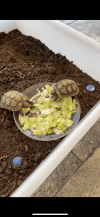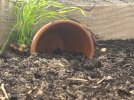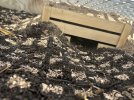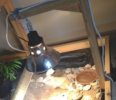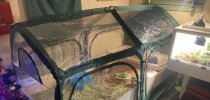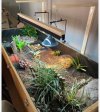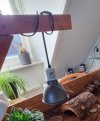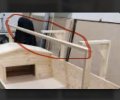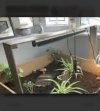Melonero
New Member
Hi guys, I’m new writing in this forum, but I’ve been reading since I have tortoises and I’m interested in them.
First of all, English is not my mother language but I’ll try my best.
I know a person that have a lot of tortoises in semi-wild conditions, they are in a land that she owns. She can’t care all of them, and she offered me two, I accepted but I don’t know well how was the condition they were.
They gave me them a month ago, and before that, I build an outdoor enclosure in my yard, the enclosure is about 2 square meters, I don’t know whether the tortoises are hermanni of graeca. And she told me they are around a year old. The tortoises are about 3 inches length. Therefore I thought that measure will be enough, When they grow up, I’ll buy a bigger one.
The enclosure have around 2 inches of top layer substrate and loosed natural dirt under.
It have 2 colder spots buried and they also can bury inside the spots. Normally in the spots is 6-7ºC colder than outside.
They also have plants and fully access to a water plate. They seemed very happy, walking around and being curious with the plants and enviroment.
My doubts are:
As I live in the mediterranean coast, temperatures in this months can reach 40ºC, though the tortoises hide in the spots, is this too much for them? I also have an sprinkler system that I can control with my phone, and when It’s too hot, I enable them. The torts will be good with that? I turn them on in the hottest hours and the temperature downs around 6ºC, I thought that the tortoises will see it as a rain. This also helps me keeping the humidity high. Even so, the tortoises are outside the spots from 9 a.m to 12:30 a.m, they eat and take direct sun. And then they hide in the cold spot until 5-6 p.m, when they eat a little more, go for a little walk and hide again, is this behavior regular?
Also, the humidity levels in my zone are in average 55%, with 80-90% in early morning, and 15-20% in early afternoon. I think is correct for them as I turn on sprinklers in this hours and the humidity level in the enclosure raise about 90%.
I would like to know if I am doing things wrong or if there is something I don't know that I need to be careful with, thank you in advance, and sorry for the grammatical errors.
First of all, English is not my mother language but I’ll try my best.
I know a person that have a lot of tortoises in semi-wild conditions, they are in a land that she owns. She can’t care all of them, and she offered me two, I accepted but I don’t know well how was the condition they were.
They gave me them a month ago, and before that, I build an outdoor enclosure in my yard, the enclosure is about 2 square meters, I don’t know whether the tortoises are hermanni of graeca. And she told me they are around a year old. The tortoises are about 3 inches length. Therefore I thought that measure will be enough, When they grow up, I’ll buy a bigger one.
The enclosure have around 2 inches of top layer substrate and loosed natural dirt under.
It have 2 colder spots buried and they also can bury inside the spots. Normally in the spots is 6-7ºC colder than outside.
They also have plants and fully access to a water plate. They seemed very happy, walking around and being curious with the plants and enviroment.
My doubts are:
As I live in the mediterranean coast, temperatures in this months can reach 40ºC, though the tortoises hide in the spots, is this too much for them? I also have an sprinkler system that I can control with my phone, and when It’s too hot, I enable them. The torts will be good with that? I turn them on in the hottest hours and the temperature downs around 6ºC, I thought that the tortoises will see it as a rain. This also helps me keeping the humidity high. Even so, the tortoises are outside the spots from 9 a.m to 12:30 a.m, they eat and take direct sun. And then they hide in the cold spot until 5-6 p.m, when they eat a little more, go for a little walk and hide again, is this behavior regular?
Also, the humidity levels in my zone are in average 55%, with 80-90% in early morning, and 15-20% in early afternoon. I think is correct for them as I turn on sprinklers in this hours and the humidity level in the enclosure raise about 90%.
I would like to know if I am doing things wrong or if there is something I don't know that I need to be careful with, thank you in advance, and sorry for the grammatical errors.

